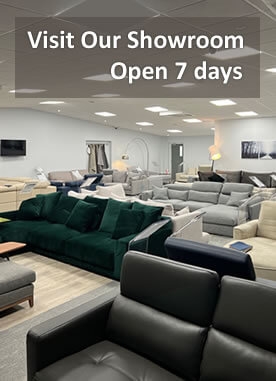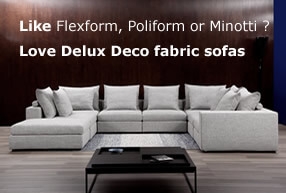Sofa Buying Guide
Buying new sofas and armchairs is a major investment and it can be quite daunting to determine the best quality for the best price. We want you to be delighted with your choice so we have pulled together information from across the internet to help with your decision.
Contents:
- Sofa Cushions Fillings (Base & Backs)
Sofa Construction
Sofa construction can vary significantly with the use of different materials and methods of construction for the frame. Generally, the frames are made with solid wood and the best furniture is made from hardwood such as oak, birch or alder. Using hardwood, particularly for the frame construction, lessens the chances for joints to loosen over time thereby increasing the life span of the sofa. Quite often plywood is used as it is a laminate material where thin layers of wood are sandwiched together using glue, with the end result being a very strong material. Plywood is generally used for the panels of sofa construction. Joints can be reinforced using glueing, screws and staples and the addition of reinforced corners.
Whilst it is ideal to have a sofa made from expensive hardwood, most reasonable quality sofas have relatively well-constructed frames. The softer parts such as the base upholstery and cushions are the main areas which take the majority of the wear and tear and it is less common to find a creaky sofa nowadays, unless you are buying at absolutely the bottom of the range.
Sofa Filling
Foam
Block foam is foam manufactured from polyurethane. It is manufactured into large blocks that are later cut down to the required size.
This type of foam is the most common material used as a sofa interior. Foam is firm and supportive and lends a more tailored appearance to a sofa. Block foam can be found in the seat cushions, arm pads and back cushions of sofas.
Block foam is soft and durable and comes in many different densities. Over the years, foam may compact and lose a little volume however this may be minimised by turning the cushions occasionally to change the areas of wear.
Fibre
Fibre is a type of filling used in sofas that is manufactured from polyester. You may be familiar with polyester fibre as it can be found inside other popular products such as teddy bears, pillows and duvets.
Fibre is a very popular choice for a sofa filling as it is very versatile and is a cheaper option to duck feathers or down. It is used in the seat cushions, arm pads and backs of sofas. It is also the filling of choice for most scatter cushions.
Sofas that use fibre in the seat cushions tend to have a soft and lived-in look, requiring some maintenance to keep them looking their best. Daily turning and plumping of the cushions is needed to maintain comfort and to prevent them from going flat.
Fibre is mostly used in sofa back cushions for a softer feel.
Foam & Feather
This is an excellent method for seat cushions as the core consists of a higher density foam, wrapped top and bottom with duck or goose feathers. These types of cushions combine the best characteristics of feather and foam, the softness, support and comfort of feather mix combined with the stability and resilience of foam.
A sofa using foam and feather will last longer than a sofa using foam only. This method is arguably equivalent to pocket springs in terms of durability and comfort.
Sofa Base Upholstery
Sofa Webbing
Webbing is an elasticated woven strap around 3 inches in diameter that is often used to support the seating platform of a sofa.
Webbing is the lowest cost option for a sofa manufacturer when it comes to the seating platform. Webbing is quick and easy for them to install by simply stretching it across the frame and securing at each side.
If you're looking for a sofa that is going to get a lot of use, say in a busy family home, then it is recommended that you avoid a webbed sofa and look for something that is steel sprung. Webbing quickly stretches and loses its elasticity with heavy use and can cause the seating area of the sofa to sink.
Steel springs, such as serpentine springs are strong, durable and will last a lot longer than webbing. Paying a little extra for quality springs may save you money in the long run.
Serpentile Springs or S Sprung
Serpentine springs are springs made from steel wire that is shaped into a continuous s shape. The steel wire used to make serpentine springs is typically 9 gauges, but can vary from one manufacturer to the next.
Steel serpentine springs are the most common type of steel spring used to support the seating platform of a sofa. High-quality sofas will sometimes have serpentine springs that are copper coated to prevent corrosion.
When out shopping for your new sofa it is worth noting how many springs are used in the construction of the sofa. More springs that are used the firmer the seating will be. Five serpentine springs per seat is recommended.
All serpentine springs should be joined together horizontally with cord. This is to ensure that all springs act as one when supporting the weight of the person sitting down. Without these joining cords the steel springs are likely to break away from their anchors or snap altogether.
Pocket Springs
Pocket springs are individual springs manufactured from high tensile steel that are then wrapped in their own pocket of fabric, hence the name “Pocket Springs”.
Pocket springs were originally designed for use in high-end mattresses. Today the use of pocket springs in sofas is becoming more and more popular. Pocket springs can be found in both removable and non-removable seat cushions.
Is a Pocket sprung sofa right for me?
The fabric pocket used to cover each spring allows them to slide up and down independently, so unlike other springing systems they don’t work together as one unit. This makes pocket springs an ideal choice if two users of the same sofa vary greatly in weight. As the pocket springs are free to move and work on their own, the heavier person should not have an effect on the person sat on the next seat.
Pocket springs can help to keep your sofa looking great. Every time you get up from a pocket sprung sofa all the springs expand. This helps to maintain the shape of the seat cushion.
A sofa using quality pocket springs will last longer than a sofa using a cheaper block foam interior. Cheap foam breaks down with time and loses its support, but with pocket springs you should get consistent support throughout the life of the sofa.
Leather Sofa Covers
Top Grain or Full Grain Leather
Full Grain leather is defined by Leather Industries of America (LIA), International Council of Tanners (ICT), International Union of Leather Technologists and Chemists Societies (IULTCS) as:
“The grain split of a hide from which nothing has been removed except the hair and associated epidermis.” Top Grain and Full Grain Leather are the same.
What does top grain leather look and feel like?
Top grain leather is one of the most luxurious leather covers for a sofa. It has a warm, inviting feel and is very soft to the touch. As top grain leather is dyed and treated differently than Aniline leather during the finishing process, the surface pigmentation has a slightly more consistent colouration, which makes this leather ideal for contemporary designer Sofa styles.
Is a top grain leather sofa right for me?
A top grain leather sofa is a great choice if you want a hard-wearing, durable and easy to clean sofa. It makes an ideal choice for a busy family home with young children and pets.
A great feature of this leather is that if liquid, such as coffee, is spilt onto your sofa the pigmented coating will resist absorption long enough for you to be able to wipe it down with a damp cloth.
The pigment coating has a great resistance to light and will not fade as rapidly as dyes that are often used to colour unfinished leathers, such as aniline leather.
Top grain leather is similar in quality to Aniline Leather which is one of the best and most durable and attractive leathers available for furnishings.
NB: Sofas upholstered in top grain leather may be initially stiffer and the leather may be less supple when absolutely new. This may occur for the first few days of use. Just as with a high-quality pair of shoes, the leather hasn't been used so this will soften with use over the proceeding days. This will only get more and more luxurious and soft over time. NB: This is not a fault when you receive your sofa, but a sign of quality and durability for the long term.
Aniline Leather
Aniline leather is manufactured from only the best quality of hides with minimal imperfections, such as bite marks and scars. Aniline leather undergoes little treatment and only aniline dye is used to colour this type of leather.
Unlike corrected grain and semi-aniline leathers, no pigment is used to coat the surface giving a very delicate and natural looking leather.
What does aniline leather look and feel like?
Aniline leather is one of the most luxurious leather covers for a sofa. It has a warm, inviting feel and is very soft to the touch. As leather is a natural product different parts of the hide will absorb different quantities of aniline dye so you will see lots of shade variation.
Is an aniline leather sofa right for me?
As aniline leather undergoes little treatment, great care has to be taken to keep this leather looking its best. An aniline leather sofa is not advisable for homes with young children and pets, or rooms where food and drink is consumed.
No pigment coating is used on aniline leather so it is very susceptible to staining. If liquid, such as coffee, is spilt on your aniline leather sofa the liquid will be immediately absorbed and will very quickly darken the affected area until it dries. This often results in a stain that will only fade with time.
The dyes used to colour aniline leather are prone to being broken down by sunlight. Prolonged exposure can cause discolouration very rapidly. In order to prevent this, be sure to keep your aniline sofa out of direct sunlight.
Sofas that use aniline leather are some of the most expensive sofas you can buy due to the quality of hide used. Be sure to consider your purchase as these sofas need a lot of care and attention to be thoroughly enjoyed.
Semi-Aniline Leather
Semi-aniline leather sits between top grain or full grain leather which may have a corrected grain and fully aniline leather. It is often manufactured from better-quality hides with fewer natural markings, such as bite marks and scars.
Semi-aniline leather has a thin coating of protective pigment to allow the natural beauty of the leather to show through.
What does semi-aniline leather look and feel like?
Semi-aniline leather tends to have a smooth feel and is one of the softest leathers available. Because only a thin layer of pigment is used to coat its surface, it may have minor evidence of natural markings and slight shade variation,but not to the same extent as in full aniline leather.
Is a semi-aniline leather sofa right for me?
Semi-aniline leather sofas are suitable for people who want to see the natural beauty of leather but would also like the durability and some of the colour consistency that comes with corrected grain leather.
Semi-aniline is a very soft leather, but it can be marked if proper care and attention is not observed. Spillages need to be blotted as soon as possible as there can be staining if liquids are left to absorb into the leather for too long. Scratches need to be treated with leather cream and/or polish.
The beauty of semi-aniline is that this is one of the softest and durable leathers available. It does have a degree of protection, but it will likely tarnish and mark over time, giving a lived-in look.
Genuine Leather
Genuine leather or Real Leather (which is the same) is a general industry term which covers a number of different leather groups.
This Covers:
Split Leather and Bonded Leather
Most of the above to varying degrees of thickness between layers incorporate the lower level of cow hide which is the fibrous part, being coated with a layer of synthetic or faux leather. This is Genuine or Real Leather.
After tanning, a leather hide is about 8mm thick which is too thick to be used on sofas. A technique called splitting is used to slice the leather into thinner more usable pieces. The top layer, called top grain, is used for more expensive applications. The bottom layers are used for suede or in the furniture industry as split leather.
Before being used on sofas the split leather has an imitated leather grain embossed onto its surface, much like corrected grain leather, creating a more natural appearance.
What does genuine leather look and feel like?
Genuine leather is very widely used in sofa coverings and is very similar in its external appearance to some higher grade leathers. The main difference is that the surface layer has a slightly colder and harder surface due to the coating of a synthetic surface which is patterned as leather.
Is a genuine leather sofa right for me?
A genuine leather sofa is a great choice if you want a hard-wearing, durable and easy to clean sofa. It makes an ideal choice for a busy family home with young children and pets.
A great feature of this leather is that if liquid, such as coffee, is spilt onto your sofa the pigmented coating will resist absorption long enough for you to be able to wipe it down with a damp cloth.
The pigment coating has a great resistance to light and will not fade too rapidly.
A genuine leather sofa will look great for some years but depending on the wear, will eventually split and crack as the synthetic layer on the surface is not as durable as a top grain or Aniline natural leather hide which may last decades compared to genuine leather at around 2 years upwards depending on wear.
Does the entire sofa come in the chosen leather?
All our sofas feature the chosen leather on all wearable parts. Non-wearable parts and parts that do not receive physical touch and areas that are mostly unseen such as the back and some side panels may use synthetic leather in a 100% matching colour. These parts do not receive any wear or touch. This is industry standard and we can quote separately for 100% full leather, if so desired.
Sofa Fabrics
Sofa fabrics offer a huge choice of colours and finishes and they usually come in a fibre mix for strength and texture. Look out for specialist sofa fabric manufactures or Italian Fabrics which are well known to be some of the highest quality and durable sofa fabrics available.
- Microfiber fabrics are easily wiped down and ideal for a home with children or pets
- High maintenance fabrics such as silk or Suede will need extra care
- Textured fabrics show less wear and tear than smooth ones





